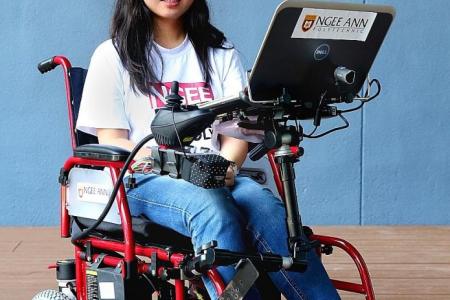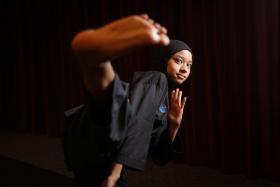Poly student creates wheelchair driven by a look
She had to learn a complex programming code in one month to configure a motorised wheelchair so that it can be controlled by eye gestures.
But this was not Miss Wang Jinyu's biggest challenge.
The graduating student from Ngee Ann Polytechnic's (NP) Automation and Mechatronic Systems course spent hours on a wheelchair for more than a month, trying to test the wheelchair's controls with eye gestures.
The eye gesture tracking system was designed for people who suffer from impaired motor movements and are unable to use a motorised wheelchair on their own.
With this system, they can become more independent, which will also ease the burden on their caregivers.
 (Miss Wang Jinyu. TNP PHOTOS: GAVIN FOO)
(Miss Wang Jinyu. TNP PHOTOS: GAVIN FOO)
Miss Wang, 20, recalled the physical discomfort she experienced while testing the wheelchair: "I had to constantly stare at the screen and try not to move my neck.
"I can't imagine how much more difficult it must be for a patient who cannot move."
CHALLENGE
The project, which took more than three months to complete, allows patients to control their wheelchair by emulating the joystick control of the motorised wheelchair with their eye movements.
It consists of a laptop with an eye tracker, which is connected to a motorised wheelchair.
Another challenge Miss Wang faced was to ensure that the system would be able to differentiate between deliberate eye movements and unconscious blinking.
To deal with this, Miss Wang had to modify the system so that it would filter out jittery eye movements.
For safety, the system was designed to stop the wheelchair from moving as soon as the patient closes his eyes or looks away.
Her project adviser, Mr Edwin Ho, senior manager of NP's Mechanical Engineering division, said that other commercial products that use eye gestures and brain waves to control movement could easily cost more than $5,000.
In contrast, their project uses an eye tracker that costs only $137.
Mr Ho said: "I'm proud of Jinyu's results. She was able to pick up a difficult programme as well as write an algorithm from scratch that allows the patient to control the wheelchair in a natural and intuitive way."
There are plans to expand this project so that these patients can use eye movements to operate household appliances such as lights.
Get The New Paper on your phone with the free TNP app. Download from the Apple App Store or Google Play Store now



